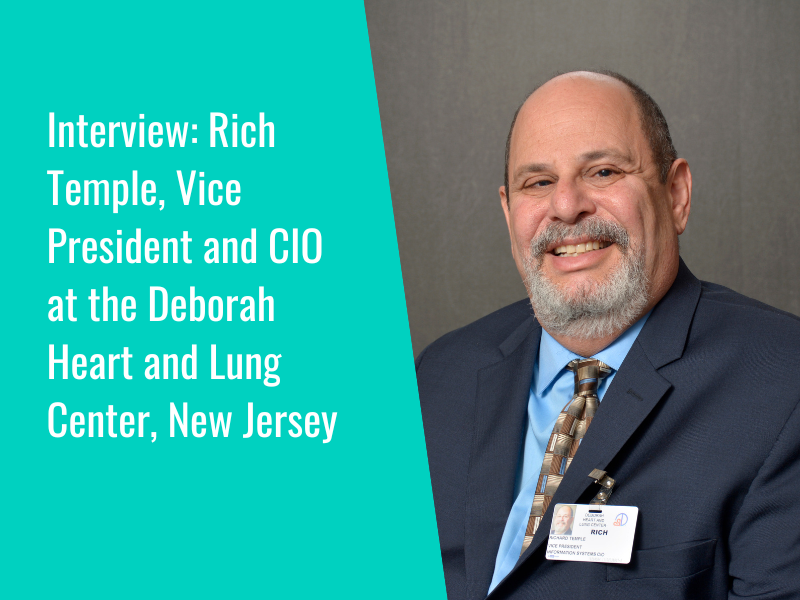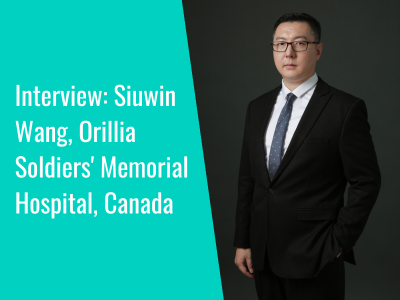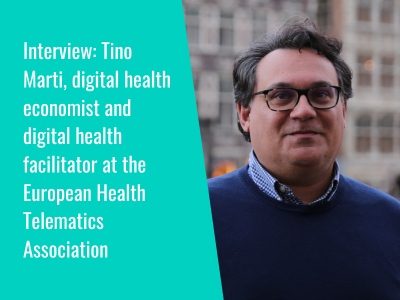For our latest HTNI interview, we sat down for a chat with Siuwin Wang, director of business analytics and health information management at Orillia Soldiers’ Memorial Hospital in Canada. Siuwin shared insights into some of the data-focused projects taking place at the hospital, his hopes for the future of data, what it means to be a leader of digital change, and more.
Siuwin explained that his role spans the entire data spectrum, from data collection through to data reporting. This includes patient registration, taking into account different data entry points such as appointment scheduling, calls and dictation/transcription services, and also covers the coding and transcribing of information into the ICD (International Classification of Disease) system. Siuwin’s team perform data quality checks to identify missing information, and also oversee data analytics within the organisation through dashboard development.
“We still have paper records, so we manage those as well, and we provide support to the leadership teams within the hospitals,” Siuwin said. “Ultimately we are covering the whole school of data, which is very exciting.”
More recently, he added, the hospital has started to embark upon projects utilising artificial intelligence, including a project that Siuwin hopes will “help us predict staffing needs for the organisation”.
As part of his remit, Siuwin helps to oversee digital transformation at the hospital, particularly around implementations and upgrades of projects such as the electronic health record, patient portal and e-referral system. For context, Siuwin shared that Orillia Soldiers’ Memorial Hospital’s EHR is run by a local hospital information cluster named GBIN (Georgian Bay Information Network); they are the conduit between the hospital partners and the EHR vendor (CERNER).
“This hospital is a very good size – with larger hospitals I think you have a narrower scope for work, but here I feel that I can be involved in different areas and experience different projects. It’s part of the excitement of my role,” he reflected.
Getting into data, and developing the next generation
Siuwin said that although he originally pursued a career as a medical doctor, but in his second year of university he realised that this was not the path he wanted to take. “At that start, I started to do some volunteer work at a hospital in Toronto and that exposed me to the health information management field. I saw how people can work with data, how patient information can help the workflow. That really opened my eyes and my interest in data started to grow.”
He continued: “I knew I still wanted to work in healthcare, but not as a doctor in that capacity. So I looked into what education programmes were out there and I started there, completing a college programme to get my foot in the door in terms of health information management.”
Siuwin started working as a clerk for health records he said helped him to “understand the basic, fundamental working pieces for patient record handling.” From there, he became a data analyst before gaining managerial experience and going back to university to complete a Master of Health Administration at University of Toronto (IHPME – Institute of Health Policy, Management and Evaluation) to further his leadership training. “That really made a difference for me – I came out of that programme thinking about what I can change and influence, and what I can bring to the healthcare system.”
Alongside his role at Orillia Soldiers’ Memorial Hospital, Siuwin shared that he “still has a passion to teach and to grow others”. He holds a post as a part-time lecturer and professor, which he said helps him to “connect with the field and see what the need is for the next generation, the workforce that is coming into the field. It also helps me bring the gaps and challenges of real-life scenarios into a school environment.”
Data projects at Orillia Soldiers’ Memorial Hospital
Siuwin expanded on some of the data-focused projects at Orillia Soldiers’ Memorial Hospital, sharing a high-level perspective on the work in this area.
“When I started at the hospital, I was tasked with the development of the data analytics vision strategy for the organisation,” he said. “I did a lot of engagement with different stakeholders, to help me understand day-to-day business challenges and focuses. I also did a lot of work with the whole leadership team at the hospital, bringing in all the directors, clinical and non-clinical. I asked them the key question: if we have a data solution, what is in it for them? How can that solution help them to move forward with their day-to-day operations?”
This type of thinking was somewhat new for the hospital, Siuwin explained. “There were no business intelligence tools in place at the time – this was three years ago, and it was still Excel-based. With my BI experience, I used data visualisation tool Tableau to help tell data’s story. I wanted to build more of a connection between the data from a technical perspective and the non-technical audiences. In that sense, my role was to be a knowledge broker between the two groups. I was ultimately building buy-in to undertake transformation, to change the data culture and change the conversation at the leadership level.”
Ongoing customer engagement is key, he added. “The solution we provide today may be good for today, but next week or next month, that might change. We need to keep open communication to understand the need from the business and user side that might change.”
For teams within the hospitals, every dashboard developed is seen as a mini project in itself, with a need to identify requirements and data availability and then release the data; but Siuwin emphasised the importance of continued iteration, to keep enhancing and makes changes where needed.
Future aspirations with digital and data
At present, Siuwin acknowledged, there is a challenge when it comes to moving from paper to digital transformation, with a lot of information still being documented on paper. One of the projects around infrastructure focuses on this work, to help transform records into an electronic format. “This will involve an upgrade of the electronic health record systems – we are planning to do this over three years.”
Siuwin shared that his hospital is part of the Health Information System Cluster, made up of six local hospitals sharing the same instance for Cerner. “Our partnership is going to come together to talk about the need as a collective,” he said. “So we will talk about doing the system upgrade together for all organisations at the same time. It also helps because it gives us that standardised approach, but we also need customisation and flexibility within that as each hospital may be experiencing different challenges. Building that foundation to enable us to collect more electronic health data and to better use our data.
Another project sees focus placed on building data pipelines. “Some of the data sources are very dispersed, they are in different siloes and they can’t really talk to each other. We want to centralise these data pipelines and our processes to enable automation. That will also improve our readiness for data governance, and once we have worked on that, we will be in a better place to talk about AI readiness. Everyone’s talking about AI, but the question is what can we actually do with it and how can it return on the effort that we put into building it.”
Workplace culture and attitudes
“When you talk about data, you want everything to be measurable so that you can quantify it,” commented Siuwin, “but generally, when it comes to attitudes, you have to talk in a qualitative sense.”
With stakeholders, he continued, it is important to understand where they are at from a data literacy point; at Orillia Soldiers’ Memorial Hospital, the leadership team all undertook a data literacy education session which “really helped to set that context” and identified a number of gaps in understanding.
He described how he prefers to undertake this engagement work up front rather than waiting to act reactively. “We want people talking about data and seeing the importance of it, understanding the impact and that quality is key. Also, everyone obviously focuses on what is important for them at any given moment – data and its quality likely isn’t their scope of work. So how can we change that conversation towards data quality responsibility for everybody? Data is going to be everywhere for everybody, and everything we do will generate data points. That requires a shift for the organisation.”
As part of his educational work, Siuwin has a number of publications on data literacy work at the Canadian Health Information Management Association and is set to deliver another session this summer breaking down data literacy and AI for the Couchiching Ontario Health Teams.
What does it mean to be a leader of change?
“Embracing new technologies means changing,” Siuwin reflected. “Being open to this means you can always find ways to improve. It also means that change management is going to be an important focus for leaders in taking users with them on that journey, from an adoption and a utility perspective. You want technology to help people solve their day-to-day problems.”
It’s also about keeping in mind how digital and data fits with the wider business and its priorities and challenges, he added. “It’s fitting puzzles pieces together, and you might need more of a system-wide lens to inform your choices.”
Siuwin also highlighted the importance of collaboration. “Collaboration is key both internally and externally. “From that system perspective, what are some of the projects and initiatives that other people have already done, and how can we learn from them? Are there any pioneers out there who have already taken the lead on the implementation of new technologies, or can we share our knowledge with others? I really think there needs to be more of an open dialogue between organisations.”
On this note, Siuwin emphasised the importance of tying data to clinical outcomes despite the fact that data teams are not patient-facing. He pointed out that one of the challenges in this space can be measuring return on investment, or measuring success. “When you invest in technology, there’s always an element of risk as well as the financial cost – not just the cost of the technology but the team’s time and effort too. But if someone else has already implemented the tech and they’ve seen value, it can help with this. People want to see to believe, so that collaboration can help demonstrate how tech does make a difference to care.”
He summarised: “Being a leader in the digital health space is about understanding the business case and how it can inform or change what we do; managing that change; and then learning how to share.”
Many thanks to Siuwin for taking the time to share his thoughts.
- 1
- 2














